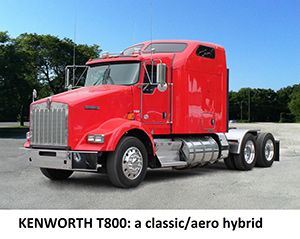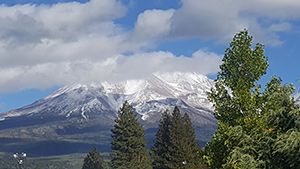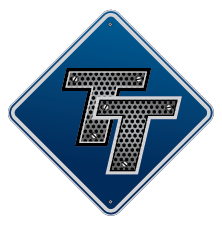About The Accelerators In PACCAR Trucks.
Topic 19676 | Page 1
I drive Pete's and KW's at my local job and I honestly have never bothered to notice the length of the pedals. I just sit down and drive.
As far as the link goes, truckers will complain about anything. I dont see how an inch or two makes such a big difference. Whatever you drive, you'll get so familiar with it that you'll know when the engine isn't behaving normally.
If you're considering this as a career, I would pay no attention to stuff like this because chances are you won't be in a KW or Pete since most carriers use Freightliners.

I drive Pete's and KW's at my local job and I honestly have never bothered to notice the length of the pedals. I just sit down and drive.
As far as the link goes, truckers will complain about anything. I dont see how an inch or two makes such a big difference. Whatever you drive, you'll get so familiar with it that you'll know when the engine isn't behaving normally.
If you're considering this as a career, I would pay no attention to stuff like this because chances are you won't be in a KW or Pete since most carriers use Freightliners.
Thanks, Mr. B:
Hopefully, Freight "shakers" have a comfy gas pedal. Do they really SHAKE as badly as they are reputed to do?
I guess that helps guard against dozing off behind the wheel. All that noise.
EPU:
Electric Auxiliary Power Units
Electric APUs have started gaining acceptance. These electric APUs use battery packs instead of the diesel engine on traditional APUs as a source of power. The APU's battery pack is charged when the truck is in motion. When the truck is idle, the stored energy in the battery pack is then used to power an air conditioner, heater, and other devices

I drive Pete's and KW's at my local job and I honestly have never bothered to notice the length of the pedals. I just sit down and drive.
As far as the link goes, truckers will complain about anything. I dont see how an inch or two makes such a big difference. Whatever you drive, you'll get so familiar with it that you'll know when the engine isn't behaving normally.
If you're considering this as a career, I would pay no attention to stuff like this because chances are you won't be in a KW or Pete since most carriers use Freightliners.
Thanks, Mr. B:
Hopefully, Freight "shakers" have a comfy gas pedal. Do they really SHAKE as badly as they are reputed to do?
I guess that helps guard against dozing off behind the wheel. All that noise.
I was impressed by the comfort, smoothness and quietness of the army's 5-ton M900 6x6 series trucks by AM General with an 855 Cummins engine. I was a motor pool mechanic and fixed them as well as drove them. Normally-aspirated, not blown. The air brake pedal seemed stiff and quirky: very touchy: not a natural braking feel as one gets in a car. I have driven the tractor version also with a semitrailer. The Allison 5-speed transmissions those sported were junk, however. They were seemingly made of pot metal and they easily broke right off their mounts. Fiberglass hood that opened forward ala Class 7/8 vehicles.
https://en.wikipedia.org/wiki/M939_series_5-ton_6x6_truck#/media/File:US_Marine_Corps_030224-M-XT622-034_USMC_M923_(6X6)_5-ton_cargo_truck_heads_a_convoy_departing_Camp_Matilda,_Kuwait_crop.jpg
HOS:
Hours Of Service
HOS refers to the logbook hours of service regulations.EPU:
Electric Auxiliary Power Units
Electric APUs have started gaining acceptance. These electric APUs use battery packs instead of the diesel engine on traditional APUs as a source of power. The APU's battery pack is charged when the truck is in motion. When the truck is idle, the stored energy in the battery pack is then used to power an air conditioner, heater, and other devices
Freightliners are the easiest trucks to learn how to drive in my opinion and they're very comfortable and roomy. Right now I drive a Peterbuilt 367 long nose (profile picture) and while it looks badass and makes me into a chick magnet, I wish it could turn like a Freightliner.
Freightliners only shake when they're climbing a steep hill and you're in low gear/high rpm. Otherwise they are fantastic. Even then, the shaking never bothered me much.

I've always been told "size doesn't matter." *wink*

Freightliners are the easiest trucks to learn how to drive in my opinion and they're very comfortable and roomy. Right now I drive a Peterbuilt 367 long nose (profile picture) and while it looks badass and makes me into a chick magnet, I wish it could turn like a Freightliner.
Freightliners only shake when they're climbing a steep hill and you're in low gear/high rpm. Otherwise they are fantastic. Even then, the shaking never bothered me much.
In the last five years I've driven a KW T-660 and 3 different types of Freightliner Cascadia.
I have no complaints about the Cascadias and prefer them over the anteater for the type of work I do (have I said that before).
The Freightshaker term is a holdover from the White Freightliner days, when they were all cab overs and the predominant OTR and LTL tractor in the 60's and 70's.
LTL:
Less Than Truckload
Refers to carriers that make a lot of smaller pickups and deliveries for multiple customers as opposed to hauling one big load of freight for one customer. This type of hauling is normally done by companies with terminals scattered throughout the country where freight is sorted before being moved on to its destination.
LTL carriers include:
- FedEx Freight
- Con-way
- YRC Freight
- UPS
- Old Dominion
- Estes
- Yellow-Roadway
- ABF Freight
- R+L Carrier
OTR:
Over The Road
OTR driving normally means you'll be hauling freight to various customers throughout your company's hauling region. It often entails being gone from home for two to three weeks at a time.

It's something I've never actually thought about, but now that you mention it, when I was in the oilfield, we drove peterbilt day cabs, and it had the long pedals that were hinged at the bottom.
There were several times I noticed that to push it all the way to the floor put your foot at an odd angle, and I could see how trying to maintain that for a long period of time could get uncomfortable, but, I use cruise control a lot so I don't think it would be that bad in OTR.
Now, the volvos have a pedal pretty much just like a car, and I find it to be very comfortable. I'd still drive a Pete if I had one though.
OTR:
Over The Road
OTR driving normally means you'll be hauling freight to various customers throughout your company's hauling region. It often entails being gone from home for two to three weeks at a time.
Day Cab:
A tractor which does not have a sleeper berth attached to it. Normally used for local routes where drivers go home every night.
New Reply:
New! Check out our help videos for a better understanding of our forum features

















Preview:








 TT On Facebook
TT On Facebook
Kenworths generally have short gas pedals while Peterbilts have long ones to match the long brake pedal.
What is your opinion regarding the various accelerator designs and comfort in using such all-important vehicular control?
This man says he does not like the Kenworth gas pedal for vocational driving as opposed to OTR driving claiming the small pedal causes foot fatigue.
Can custom aftermarket foot controls be had if the stock ones are not comfortable for your style of driving? Could a custom long gas pedal be installed in a KW should that be your style? My 1995 Toyota Corolla has a long accelerator pedal whch makes for a comfortable rest on long drives. Most automobiles have a long gas pedal like the Petes.
When one is considering driving a truck for a living I think ergonomics and vehicle controls play an important consideration. Perhaps the cab never should be too comfy so as to discourage falling asleep behind the wheel on long drives. The diesel International 22-foot moving truck I rented from Penske in 2006 with its cement-hard vinyl bench seat and total lack of thigh and lumbar support made me well aware of that on a 700 mile trip. Only some Dodge pickup seats have been actually worse!
Here is a video where the man gripes about the Kenworth accelerator and a few other cheesy interior items:
https://video.search.yahoo.com/yhs/search;_ylt=A2KIo9hfWCZZ1mwAHCI0nIlQ;_ylu=X3oDMTBncGdyMzQ0BHNlYwNzZWFyY2gEdnRpZAM-;_ylc=X1MDMTM1MTE5NTcwMARfcgMyBGFjdG4DY2xrBGJjawMzaG81dTQ1Y2VzcmZjJTI2YiUzRDQlMjZkJTNEOUM4b1lBVnBZRUxVZnVEREhLS3NjNmdENXl0cDl4Z00xS0lsOHctLSUyNnMlM0RzaiUyNmklM0RIemFZTHZLLkNYWEFJVURKUUdMLgRjc3JjcHZpZAN6akVsT2pZekxqSTQ0TDRoV081dDdBVmxNVFU1TGdBQUFBQlo5Q3JrBGZyA3locy1pdG0tMDAxBGZyMgNzYS1ncARncHJpZANBVlFDRThDbFQxQ2s4a01FSlNvd2pBBG10ZXN0aWQDbnVsbARuX3JzbHQDMARuX3N1Z2cDMTAEb3JpZ2luA3ZpZGVvLnNlYXJjaC55YWhvby5jb20EcG9zAzAEcHFzdHIDBHBxc3RybAMEcXN0cmwDMTQEcXVlcnkDa2Vud29ydGggdDgwMCAEdF9zdG1wAzE0OTU2ODUyMjEEdnRlc3RpZANudWxs?gprid=AVQCE8ClT1Ck8kMEJSowjA&pvid=zjElOjYzLjI44L4hWO5t7AVlMTU5LgAAAABZ9Crk&p=kenworth+t800+&ei=UTF-8&fr2=p%3As%2Cv%3Av%2Cm%3Asa&fr=yhs-itm-001&hsimp=yhs-001&hspart=itm&type=wbf_ezdnldd_17_14_ssg01#id=4&vid=7e3d1bf7414cbc67c6a0f24d76ce6673&action=view
CDL:
Commercial Driver's License (CDL)
A CDL is required to drive any of the following vehicles:
OTR:
Over The Road
OTR driving normally means you'll be hauling freight to various customers throughout your company's hauling region. It often entails being gone from home for two to three weeks at a time.
Dm:
Dispatcher, Fleet Manager, Driver Manager
The primary person a driver communicates with at his/her company. A dispatcher can play many roles, depending on the company's structure. Dispatchers may assign freight, file requests for home time, relay messages between the driver and management, inform customer service of any delays, change appointment times, and report information to the load planners.